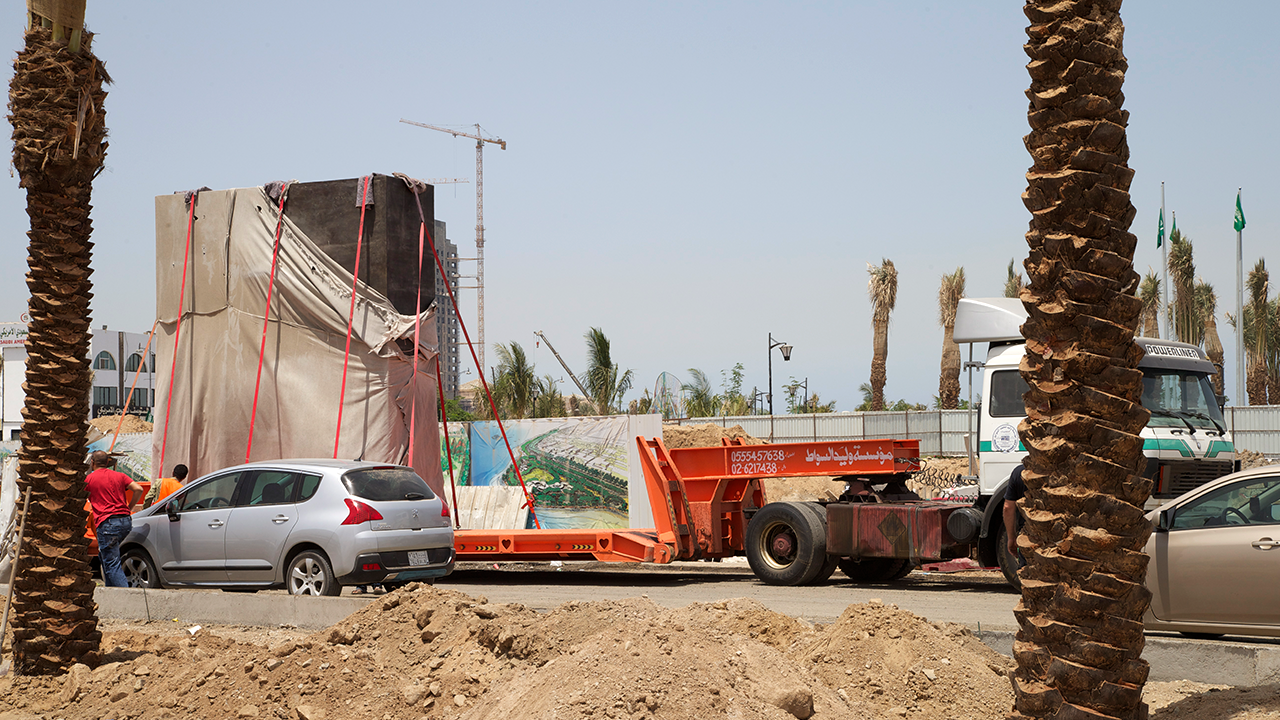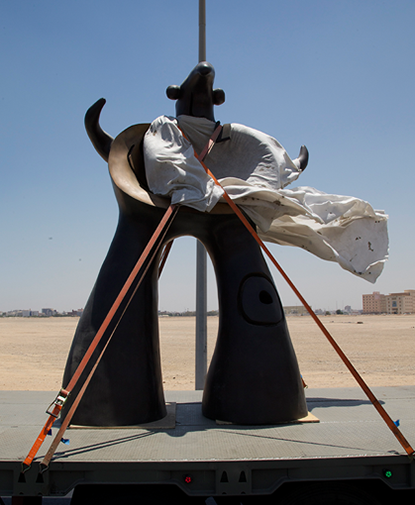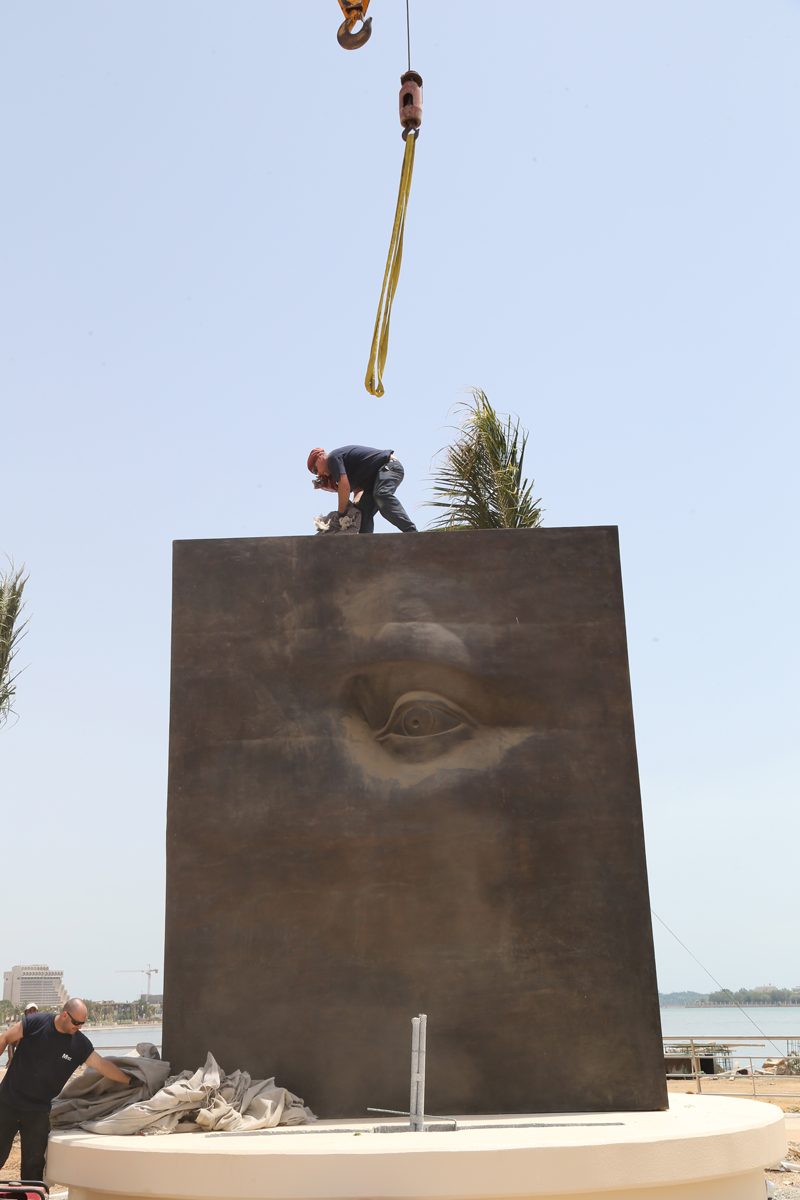

In the Spring of 2013 I visited Jeddah, and was taken by the artist and photographer, Ahmed Mater, to see the storage warehouse where the sculptures were being kept and made ready for conservation, restoration and replacement. I was struck by a sense of the works being held in this very temporary situation: existing for themselves, in between ‘rest’ and ‘mobility’, caught between ‘stasis’ and ‘being brought alive’. And I couldn’t help thinking that it was now up to the public, the new spectators of these works, to bring these half sculptures, half monuments back to life, reactivating the theatre of memory of the Jeddah metropolis.
In the sixties and seventies cities like Jeddah were not known for being hubs of cultural activity. Algiers, Baghdad, Beirut and Cairo were then the leading cities of Arab cultural renaissance. There are, however, some lesser-known and surprising stories. The scheme initiated in the seventies by the Mayor of Jeddah, Dr Mohamed Said Farsi, for the city’s renewal, by means of sculptures and urban landmarks – many of them created by international modern masters – is one such story. It was then that from the closed universe of the ancient, symbolic city of Jeddah arose an open metropolis, with a constant flow of people and goods, circulating through arteries of traffic, aligned with the signs of a new age, more international than ever before.

The horizontal structure of the metropolis connotes time and progress; its vertical structure connotes power and social hierarchy. No longer determined by proportion and measure, its spaces are arranged in a concentration of separate signs – such as the sculptures and monuments commissioned by the city of Jeddah. Indeed, the metropolis encloses a memory system at least as powerful as the built memory of ancient cities. But whereas the latter originated in a heavenly ideal, as embodied in and reflected by their symbolic layout, the modern city presents its ideal image as a means of stimulating contemporary daily life. The inclusion of sculptures in Jeddah’s new pedestrian areas, the alignment of monuments along the King Abdul Aziz Road, the displacement of some of these works when the open air Sculpture Museum was created, and their recent restoration and conservation: these are all important chapters of the same ideal and the same memory system. Whereas architecture and urban design are traditionally crafts of usefulness, aimed at building a bridge between individual experience and a collective society, the best of modern art is highly personal and cannot be made collective – or, at least, not at once. In modern art there are no metaphysical, historical or philosophical concepts working integrally for the whole of society. Modern art simply cannot express something obligatory ‘for the public’. Besides, today’s public is nobody and everybody. However, there is a positive side to the individualism and utopianism of modern art: it enables us to behave and think for ourselves. And yet there is also a collective longing, which is fulfilled and frustrated at the same time. This dialectical relationship is inherent to the question: what does public art mean today, and what can or should it do? The sculptures and monuments of Jeddah – their story and placing not least – dramatise the relationship between what we are and what we want. One might therefore state that making public art is inherently contradictory, while the idea is not. And public space, especially today in our sprawling, overdeveloped cities, is an equally problematic term. Public space has become merely a left-over space, a space not yet built upon. So we are left with the notion of public context when we try to understand the ways in which we are affected by contemporary public art, its effect upon us. What, then, is the public context in which these works will be re-encountered? Let me state, first, that the sculptures and monuments conceived for Jeddah’s urban space in the seventies have now become half sculptures, half monuments; they are ‘in between’ sculpture and monument, that is they operate in between the chronos (chronological, sequential notion of time) and kairos (time as propitious moment) of the culture of a city.

Does that mean that these works have therefore lost their original meaning? Yes, but only partially so. For they have gained a new meaning through their new life in public, being enabled to confront another age, another environment and other spectators. Indeed the desire to inscribe them again in a new – very different! – public context is a decision of great cultural importance. And a lesson for the future of public art in general. These works contain the unspoken and unspeakable language of shadows of a public life long gone. Through the restoration they might even have been altered a bit. Yet the process of placing and replacing shows the memory system of the city of Jeddah fully at work. The theatre of memory as expressed by the old and new Jeddah is ‘mobile’, and acts as a guarantee for the further development, both culturally and urbanistically, of this unique city. The new documentation expressed in this publication, through specially commissioned writing and photography, as well as the original records in Hani Farsi’s publication Jeddah: City of Art, the Sculptures and Monuments of 1991, are as important as the old and new displays. These printed materials are part of the same memory process, through which a changing culture is brought alive. The history of the sculptures and monuments of Jeddah makes it possible to read the city as a huge ideogram. These objects evoke images of life, of production as the negation of death, of history as the road of development and progress. The question, therefore, is no longer ‘What is public art?’ but rather ‘When is public art?’ Public art to my mind is only probable in a world, possibly a world of art, in which the marginalised and disenchanted spectator is allowed to be both competent and representative. When public art achieves its goal, it is first and foremost in the acceptation of a representation of both the unified and fragmented, the real and the utopian – like the very constitution of our contemporary, daily life. Public art may even help us to construe our own identity: these works – which over time have become half sculptures, half monuments – become, give way to chance encounters, discontinuous and accidental meetings. The theatre of memory expressed by and through the public art in the city of Jeddah gives us a chance to be ourselves. Not as one being, but as a multitude of beings.